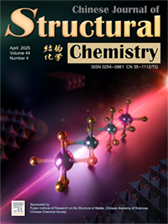
Cover Picture
High thermal conductivity in Ga2TeO6 crystals: Synergistic effects of rigid polyhedral frameworks and stereochemically inert cations
Ziyi Liu, Feifei Guo*, Tingting Cao, Youxuan Sun, Xutang Tao, Zeliang Gao* Submit a Manuscript
High thermal conductivity in Ga2TeO6 crystals: Synergistic effects of rigid polyhedral frameworks and stereochemically inert cations
Ziyi Liu, Feifei Guo*, Tingting Cao, Youxuan Sun, Xutang Tao, Zeliang Gao* Submit a Manuscript
Advancements in photocatalytic hydrogen peroxide synthesis: overcoming challenges for a sustainable future
Liyang Qin, Luna Wu, Jinlin Long*
Chin. J. Struct. Chem., 2025, 44(4), 100545. DOI: 10.1016/j.cjsc.2025.100545
April 1, 2025
Hydrogen peroxide production; Green chemistry; Solar energy; Sustainable synthesis
ABSTRACT
Hydrogen peroxide (H2O2) is a crucial, eco-friendly oxidizing agent with a wide range of industrial, environmental, and biomedical applications. Traditional production methods, such as the anthraquinone process, face significant challenges in terms of energy consumption and environmental impact. As a sustainable alternative, photocatalytic H2O2 production, driven by solar energy, has emerged as a promising approach. This review discusses the key advancements in photocatalytic H2O2 synthesis, focusing on overcoming challenges such as charge recombination, selectivity for the two-electron oxygen reduction reaction (2e− ORR), and catalyst stability. Recent innovations in photocatalyst design, including high-entropy materials, single-atom catalysts, and covalent organic frameworks (COFs), have significantly enhanced efficiency and stability. Furthermore, novel strategies for optimizing charge separation, light harvesting, and mass transfer are explored. The integration of artificial intelligence and bioinspired systems holds potential for accelerating progress in this field. This review provides a comprehensive overview of current challenges and cutting-edge solutions, offering valuable insights for the development of scalable, decentralized H2O2 production systems that contribute to a more sustainable future.







